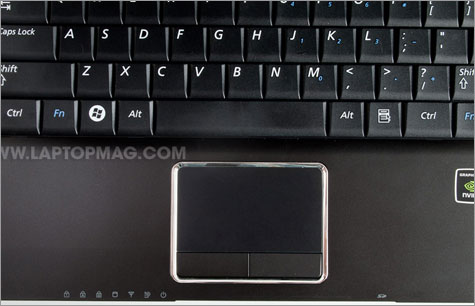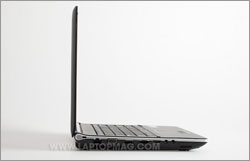Laptop Mag Verdict
Samsung's latest 13-inch notebook offers strong performance for the price, but we'd prefer longer battery life.
Pros
- +
Attractive design
- +
Good keyboard
- +
Strong performance
Cons
- -
Mediocre media playback
- -
Relatively short battery life
- -
Slow Hard Drive
Why you can trust Laptop Mag
The Samsung Q320 combines a powerful 2.53-GHz Core 2 Duo processor with a Nvidia discrete graphics chip in a compact, attractive package. Priced at a $929, this machine is generally solid, but lacks the endurance of other thin-and-light machines, and its multimedia prowess could stand some improvement.
Design
With the Q320's design, Samsung has decided less is more. The glossy black lid and matte plastic interior reminded us more of the 12-inch Samsung NC20 netbook than the glitzy Samsung X360 ultraportable we reviewed earlier this year. The simple but elegant frame is complimented by a chrome hinge, accents around the rim, and tasteful blue and orange status lights mounted on the front lip.
While it's considered "thin and light," the Samsung Q320 is not the most portable 13-inch system on the block. At 4.8 pounds and 1.4 inches thick, the notebook is larger and heavier than the Sony VAIO SR (4.2 pounds, 1.3 inches) and the 13-inch Apple MacBook Pro (4.4 pounds, 1.0 inches). The Dell Studio XPS 13 is the same weight, but, at 0.9 inches, is approximately half an inch thinner.
Keyboard and Touchpad
The 87-key traditional (non-island-style) keyboard on the Q320 has solid key placement, and offers strong tactile feedback with no noticeable flex. Using the Ten Thumbs Typing Tutor test, we were able to type a strong 80 words per minute with only a 1 percent error rate. The only drawback was that, at certain times, the left side of the wrist rest would get a bit hot (we measured it at 97 degrees), and the heat was unpleasant.
Click to enlarge
Sign up to receive The Snapshot, a free special dispatch from Laptop Mag, in your inbox.
The low-friction touchpad is reasonably sized and supports a few multitouch gestures, including pinching to zoom in/out on a Web page or photo. The buttons are easy to click and provide good tactile feedback.
Display and Audio
The Q320 sports a very glossy 13.4-inch, 1366 x 768-pixel screen. Even with the screen at full brightness, we were able to see a fairly accurate reflection of ourselves in it. Color quality was good, but unspectacular when the screen was titled back all the way. At a fully upright position, pictures washed out. Colors stayed consistent when viewing from a 45-degree angle, but reflections covered more of the screen.
Click to enlargeForget about using the Samsung Q320 as an entertainment device. The bottom-mounted speakers produced loud, but tinny and distorted sound when playing music or watching videos. Video was grainy and filled with noise, both when we played a DVD of Dark City and when streamed a high-definition episode of Fringe from Fox.com
Ports and Webcam
The Q320 comes equipped with the standard set of ports you'd expect from a modern multimedia notebook. The right side features a slot-loaded DVD player and a standard USB 2.1 port. The left side has an ExpressCard/34 slot, an eSATA/USB 2.0 combo port, another regular USB 2.0 (which can be used to recharge peripherals even when the system is turned off), Ethernet, HDMI, VGA, headphone and mic ports, and a Kensington lock bay. The front lip has a 3-in-1 memory card reader.
The 1.3-megapixel webcam provided average color quality, but images were noisy and there was noticeable flicker, both when videoconferencing on Skype and when using the bundled CyberLink YouCam photography tool.
Temperature
Click to enlarge
We measured the temperature of the Q320 when running our battery test in a non-air conditioned room. We consider temperatures below 95 degrees Fahrenheit to be acceptable, so the 94 degrees we measured between the G and H keys, 95 degrees we found on the touchpad, and 91.5 degrees we observed on the back bottom were all acceptable. However, the left side of the wrist rest was an unpleasant 97 degrees, which is just where we placed our left hand when typing.
Performance
The combination of its 2.53-GHz Core 2 Duo Processor and 4GB of RAM gave the Q320 a strong score of 3,799 in PCMark Vantage, a benchmark, which measures overall system performance. This score was well above the 3,048 average for thin-and-light notebooks and also better than the 3,174 provided by the Sony VAIO SR, the 3,207 returned by the 13-inch MacBook Pro in Boot Camp, and the 3,187 scored by the Toshiba Satellite U505. However, the Dell Studio XPS 13 came out slightly ahead with 3,961.
The Samsung Q320's discrete Nvidia GeForce G105M graphics chip helped it score 2,595 in 3DMark06, which was way ahead of the 1,479 category average and also stronger than the Sony VAIO SR (2,450), MacBook Pro (2,174), and integrated graphics-packing Toshiba Satellite U505 (999). However, the Dell Studio XPS 13, which uses a more powerful Nvidia GeForce 9500 GE GPU, scored a much higher 3,530.
Using HandBrake, Samsung Q320 was able to transcode a short MP4 video clip to AVI in 7 minutes and 3 seconds, which is 6 seconds slower than the category average (6:57), but faster than the Sony VAIO SR (7:41) and the Toshiba Satellite U505 (7:25). The Dell Studio XPS 13 (6:31) outpaced it by more than 30 seconds while the MacBook Pro was about even with the Q320 when running this test under Windows Vista (7:01).
As the Q320's GPU is CUDA enabled--which lets compatible programs offload much of the work from the processor to the graphics chip--we performed the transcoding test using vReveal, which takes advantage of this technology. This time, the Q320 finished the task in just 3 minutes 21 seconds, less than half the time of when using HandBrake.
In Far Cry 2, the Q320 managed a playable 28.7 frames per second at 1024x768 resolution, which is well above the 20 fps category average and better than the Apple MacBook Pro (25 fps), Dell Studio XPS 13 (25.8 fps) and Toshiba Satellite U505 (6 fps). However, the Sony VAIO SR was a little stronger with 29.3 fps. Don't try playing games at the screen's native 1366 x 768 resolution, however, as the system managed only 6.8 fps.
Hard Drive
The Q320's 320GB Hitachi 5,400-rpm hard drive was not as strong as the system's CPU and graphics chip. It performed the LAPTOP File Transfer Test (copying 4.97GB of files), at a glacial rate of 14.9 MBps, well below the category average of 19.6 MBps and comfortably behind the Sony VAIO SR (16.6 MBps), Toshiba Satellite U505 (21.7 MBps), and Dell Studio XPS 13 (15.9 MBps).
Despite the slow hard drive, the Q320 managed to boot Vista in a respectable 60 seconds, which matches the category average. Of its closest competitors, the Toshiba Satellite U505 (55 seconds) and Apple MacBook Pro (57 seconds in Boot Camp) started faster.
Wireless
The Samsung Q320's Realtek RTL8192E 802.11n wireless card managed very strong transfer rates of 25.4 Mbps and 19.7 Mbps from 15 and 50 feet, respectively. These numbers were well above the category averages of 19.6 and 15.5 Mbps, and they beat the pants off of the Dell Studio XPS 13 (19.4/14.2 Mbps), Sony VAIO SR (19.2/16.1 Mbps), Toshiba Satellite U505 (21/19.9 Mbps), and MacBook Pro (22.9/16.9 Mbps).
While all the requisite ports are present, we were surprised to find that the Q320 does not come with a Bluetooth radio, particularly since Bluetooth is nearly standard on anything more than $600. If you want to connect wirelessly to a cell phone or Bluetooth headset, you'll need to buy a USB dongle.
Battery Life
If you're using the Q320, don't leave home without the power brick. On the LAPTOP Battery Test (continuous Web surfing over Wi-Fi), the Q320's 6-cell battery lasted a disappointing 3 hours and 28 minutes. This number was 46 minutes less than the category average (4:14) and well behind the 4:26 offered by the Sony VAIO SR and the 6:13 the MacBook Pro lasted in its native Mac OS X. The Q320's below-average endurance is the price you pay for having discrete graphics. However, the Dell Studio XPS 13 lasted only 2:37.
The battery itself does have one unique feature: a capacity meter that lights up when you press a button it and shows you how much juice the system has left, even if the computer is off. Unfortunately, it's not very accurate, as it goes only in increments of 20 percent. Even after we'd run the battery dry, and could not power on the system, the battery meter showed 20 percent remaining.
Green Testing
Despite having discrete graphics, the Q320 is relatively power efficient. The notebook took just 2 hours and 6 minutes to fully recharge. It consumed an average of 50.4 watts during that time, for a total of 6,350.4 watts. Using this information, we derived the LAPTOP Battery Efficiency Rating (dividing the total wattage by the battery life in minutes), which came to 30.5, merely 1 watt higher than the thin-and-light average, and well below the 56.8 rating garnered by the Dell Studio XPS 13. Also, the Q320 received a Gold rating of 21 (out of 28) from EPEAT (Electronic Product Environmental Assessment Tool).
Configurations and Upgrades
Click to enlarge
Samsung offers the Q320 only in the configuration we reviewed. However, if you're unhappy with the pokey hard drive, you can easily swap it for any 2.5-inch SATA drive, including an SSD. The system comes with 4GB of DDR2 RAM, which is the maximum amount it can hold.
Software and Warranty
The Q320 comes with a standard suite of Samsung utilities that includes Samsung Magic Doctor for diagnosing system problems, Samsung Battery Life Extender for power management, and Samsung Recovery Solution III for backing and restoring. In addition, it has a suite of entry-level DVD and webcam utilities from CyberLink, including a burning program, a DVD player, and a webcam recording application.
Samsung covers the Q320 with a one-year warranty that includes parts and labor. Phone support is available 7 days a week, 9 am to 9 pm EST. Live chat is available on the Samsung Web site from 8 am to 12 am EST Monday thru Friday.
Verdict
At first glance, Q320 seems like a bargain, because it is significantly less expensive than 13-inch competitors with discrete graphics, such as the Dell Studio XPS 13 ($1,354) and Sony VAIO SR Series ($1,359). Unfortunately, a hefty frame and short battery life make the notebook less portable than we'd like, and multimedia playback could be better. If you're willing to sacrifice discrete graphics, the Toshiba Satellite U505 ($799) is $130 cheaper. Nevertheless, if you're looking for copious processing power and good graphics performance in a 13-inch chassis, the Q320 makes a solid choice at a compelling price.
Samsung Q320 Specs
| Brand | Samsung |
| CPU | Intel Core 2 Duo P8700 2.53GHz |
| Card Slots | 3-1 card reader, ExpressCard/34 |
| Company Website | www.samsung.com |
| Display Size | 13.4 |
| Graphics Card | Nvidia GeForce G105M |
| Hard Drive Size | 320GB |
| Hard Drive Speed | 5,400rpm |
| Hard Drive Type | SATA Hard Drive |
| Native Resolution | 1366x768 |
| Operating System | MS Windows Vista Home Premium (64 bit) |
| Optical Drive | DVD RW |
| Optical Drive Speed | 8X |
| Ports (excluding USB) | eSATA, Audio-out, Audio-in, HDMI, Ethernet |
| RAM | 4GB |
| RAM Upgradable to | 4GB |
| Size | 12.83" x 9.0" x 1.44" |
| USB Ports | 3 |
| Video Memory | 256MB |
| Warranty/Support | 1 year parts and labor |
| Weight | 4.8 pounds |
| Wi-Fi | 802.11a/b/g/n |





